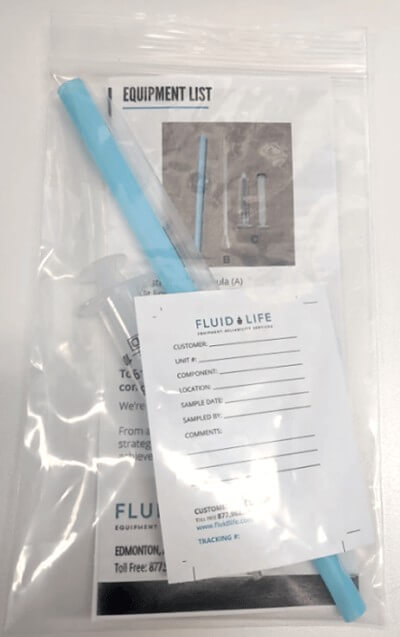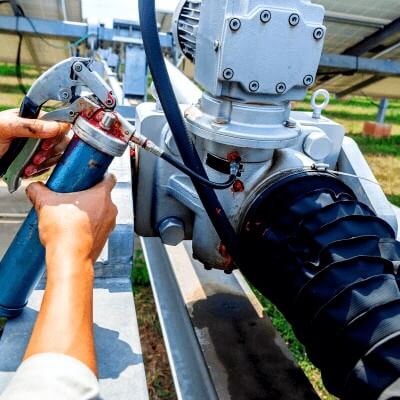Performing grease analysis on a routine or as-needed basis provides useful information about the condition of the grease and bearing, while gauging the effectiveness of your maintenance strategy.
Grease is the preferred choice of lubricant for a variety of situations including:
- Low-speed, back and forth, or minimal bearing rotation (i.e. oil circulation doesn’t work very well)
- High risk of shock loading / bearing deflection
- Sealing or leakage control
- Oil incompatibility concerns (i.e. zinc-based oils in an electric motor bearing)
- Serviceability concerns (i.e. restricted access, remote access)
These issues are carefully considered during design of the system and are just as important during operation. These conditions are often the exact failure modes that need to be monitored and controlled.
Common Grease Applications
The following are common applications for grease lubrication:
- Bearings
- Ball, Roller, Plain Bearings
- Electric Motor Bearings
- Large Caster Bearings / Slew Rings
- Wind Turbine Bearings: Main, Yaw, Generator, Pitch Adjustment
- Couplings / Linkages
- Gears
- Chains
- Joints
- Robotic Arms
- Automatic Lubrication Systems

Grease Testing Options & Resources
With nearly 90 percent of all bearings being lubricated with grease, routine grease testing and analysis is an important part of your preventive and predictive maintenance programs. Download the quick reference recommended Grease Testing Packages overview.
Screening Test Package
Routine Tests: Color, Total Magnetic Iron (TMI), FTIR Identification
Sampling Frequency: As needed
Applications:
- Small Electric Motors
- Chain Grease
- Mobile Joints
- Wheel Bearings
Standard Test Package
Routine Tests: Color, Total Magnetic Iron (TMI), FTIR Identification, Penetration Test (unworked), ICP Spectrometry
Sampling Frequency: 2x per year or as needed
Applications:
- Large Electric Motors
- Automatic Greasing Systems
- Robot Arms
Advanced Test Package
Routine Tests: Color, Total Magnetic Iron (TMI), FTIR Identification, Penetration Test (unworked), ICP Spectrometry, RULER (Remaining Useful Life) of Grease, Analytical Ferrography
Sampling Frequency: 2x per year or as needed
Applications:
- Large Diameter Bearings
- Rolling Element
- Trunnion/Plain
- Troubleshooting Bearing Failures*
- Condition-based Grease Program*
- Confirmation Of
- Grease Quality*
- Grease Stability*
- Grease Compatibility*
*May require additional, triggered, or custom tests. Contact Fluid Life for more information.
Download the Grease Analysis individual test overview.
When deciding to make a lubricant change, grease compatibility must be taken into consideration. Whether two greases are compatible depends on:
- Thickener type
- Base fluid
- Resulting grease properties after mixing
While the compatibility chart provides a general guideline to determining the basic compatibility between two greases, a grease compatibility test is recommended when critical applications are involved.
As with any lubricant, we recommend that you consult the equipment service manual or contact your machinery manufacturer to see what they recommend when determining what grease to use in your specific application. The safest practice is to avoid mixing of greases.
Fluid Life can also conduct grease compatibility tests – contact us to find out more.
Clean the sample point to prevent cross contamination of grease from other components. Contamination and old grease should be removed using the wide end of the coring spatula.
For thinner and spreadable greases, the slitted coring tube is often preferred.
- Insert the slitted coring tube into the sample point and rotate multiple times to core a representative sample. The tube should have greased plugged inside and residual grease on the outside.
- Place the grease filled coring tube into the empty syringe. Hold the combined tube / syringe in a gloved hand or with a paper towel.
- Using the hand firmly holding the syringe and tube together, pinch the tube above the point at which grease has accumulated on the tube.
- With the other hand, pull the coring tube away from the syringe extruding the collected grease on and in the coring tube, leaving it in the syringe barrel.
- Wipe clean any excess grease that may be on the outside of the open end, and ensure as much grease as possible is compacted into the syringe.
- With the grease sample packed into the syringe, align the rubber tipped syringe plunger, and re-insert it.
- Push the head space out of the syringe until the grease sample fills the dead space. Screw on the luer lock cap to the tip to seal the sample. 5 mL sample minimum required.
For thicker and stickier greases, the plastic coring spatula will allow for more consistent retrieval of grease from the sampling point.
- Using the narrow end of the coring spatula, scoop out grease from the representative sampling location, and pack it in the empty syringe barrel. Continue this process until you’ve accumulated a minimum of approximately 5 mL minimum of grease.
- When finished, place the coring spatula into the syringe, and extrude the residual grease into the syringe barrel with the ‘pinch and pull’ method shown for the Slitted Coring Tube (above).
- Wipe away residual grease from the opening, and re-insert the rubber tipped syringe plunger. Push the head space out of the syringe until the grease sample fills the dead space of the syringe. Screw on the luer lock cap to the tip to seal the sample.
Grease sampling test kits are available for purchase from Fluid Life. Contact the Order Desk at 877-962-2400 or via email.

The following list of best practices will help to improve the overall quality of your grease lubrication program:
- Dedicate a grease gun to a grease type and tag it using a unique color or shape coding and clear lettering.
- Avoid mixing greases with incompatible base oils, additives, and thickeners – always consider grease compatibility when changing grease.
- Regularly calibrate your grease application guns in case the gun’s output per shot changes.
- Keep guns clean and avoid laying them on dirty surfaces. Repack on a clean bench using a gun loader fitting. Keep covered when not in use.
For additional best practices, read our 6-Step Guide to an Improved Greasing Procedure.

ADDITIONAL INSIGHTS
Take the next step
Depend on over 40 years of experience in fluid testing and analysis to improve your predictive maintenance programs and reduce unplanned downtime.
Contact Fluid Life to develop and implement a grease analysis program that fits your needs.
WE’RE FLUID LIFE. ALWAYS RELIABLE. ALL WAYS.
Call: 1-877-962-2400
Talk to a Fluid Life Representative
